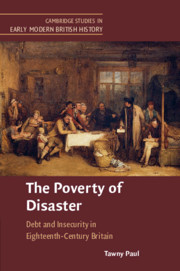Book contents
- The Poverty of Disaster
- Cambridge Studies in Early Modern British History
- The Poverty of Disaster
- Copyright page
- Dedication
- Contents
- Figures
- Tables
- Acknowledgements
- Introduction
- Part I Structures of Insecurity
- Chapter 1 The Scale of Incarceration
- Chapter 2 Credit and the Economic Structures of Insecurity
- Chapter 3 Social Structures of Insecurity
- Part II The Insecure Self
- Part III The Debtor’s Body
- Bibliography
- Index
Chapter 2 - Credit and the Economic Structures of Insecurity
from Part I - Structures of Insecurity
Published online by Cambridge University Press: 27 September 2019
- The Poverty of Disaster
- Cambridge Studies in Early Modern British History
- The Poverty of Disaster
- Copyright page
- Dedication
- Contents
- Figures
- Tables
- Acknowledgements
- Introduction
- Part I Structures of Insecurity
- Chapter 1 The Scale of Incarceration
- Chapter 2 Credit and the Economic Structures of Insecurity
- Chapter 3 Social Structures of Insecurity
- Part II The Insecure Self
- Part III The Debtor’s Body
- Bibliography
- Index
Summary
Chapter 2 explains why middling people were so vulnerable to imprisonment through analysis of structures of credit and wealth. Drawing on debtors’ schedules, or inventories of wealth generated by the imprisonment process, the credit networks and patterns of wealth-holding of middling households are reconstructed. I argue that the portions of middle ranking wealth bound up in credit, changing structures of credit and middling people’s positions within credit networks rendered them vulnerable to failure. Analysis of how middling people held their wealth suggests that they did not lack assets, but rather faced problems of liquidity. Incarceration was the consequence of endemic structural insecurities.
Keywords
- Type
- Chapter
- Information
- The Poverty of DisasterDebt and Insecurity in Eighteenth-Century Britain, pp. 67 - 94Publisher: Cambridge University PressPrint publication year: 2019
- 1
- Cited by

